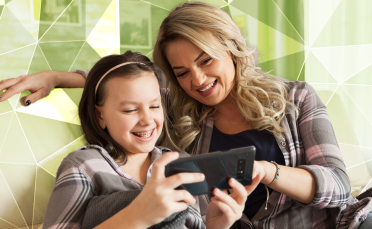Book Review: The Anxious Generation

You’ve probably felt the pull, maybe at the end of the day as you sink into a favorite chair and start scrolling. You marvel at how quickly an hour can pass and feel frustrated because you meant to accomplish other things. It takes a huge effort to put the phone down and turn to folding the laundry, doing the dishes or walking the dog.
If you are a parent or someone who works with kids, you’ve likely watched an adolescent pause to answer a text while working on homework with a video playing in the background and music running through one earbud. You’ve probably also heard stories about or lived through epic battles over screen time or problems with cyberbullies. You’ve seen that your kids or your students and their friends are constantly tethered to their devices, texting, posting, reacting and scrolling nearly all the time.
So what’s the difference between the two scenarios? An adult wastes time scrolling Instagram and has a hard time putting the phone down. An adolescent is literally always online. According to Jonathan Haidt, author of The Anxious Generation: How the Great Rewiring of Childhood Is Causing an Epidemic of Mental Illness — well, the subtitle sort of gives it away, doesn’t it? Haidt’s central idea is that the large upturn (an increase of around 150%) in major depressive episodes in teens that started around 2012 is the result of a shift to a phone-based childhood that has literally rewired their brains. Although everyone feels some of the symptoms of too much phone use now and then, people born before 1995 were not subject to the same effects because the technology wasn’t yet available in their formative years.
Haidt lays out a convincing case that smartphones, because they target the reward-seeking parts of our brains, are particularly damaging to children because the areas of their brains responsible for self-control, delayed gratification and resistance of temptation are much slower to mature. No one who’s ever tried to tear a toddler away from a playground or motivate a sulky adolescent to clean their room is surprised by this bit of brain science. But where does the depression come in?
I should note here that Haidt draws on social science as well as brain science research to build his argument, and there’s plenty of room for different interpretations. Some researchers have publicly stated that they disagree with Haidt for various reasons (correlation vs. causation, quibbles with the idea of “rewiring” brains, assertions that he is fear-mongering, etc.). But regardless of the specific mechanisms or the severity of the effects of too much phone use, it’s difficult to argue with some of the observable problems, and Haidt’s advice for parents, schools, governments and tech companies is solid even if technology turns out to be only a small contributing factor to mental health problems among our youth.
Opportunity Cost and Depression
Haidt does a good job explaining how too much screen time contributes to or even causes mental health problems. As children grow into adolescents, their brains change. They need to build independence from their parents and find ways to belong, and they do this by gaining an array of experiences. They need to assume responsibilities, learn to interact with others and gain confidence in navigating the outside world. They can do this by doing chores around the house, engaging in free play with other children, walking to a local park, buying something at the store, cooking a meal, and so on. One major problem with screens is that they carry a heavy opportunity cost: Time spent on a smartphone or iPad is time not spent doing what kids need to do to develop healthy minds.
Haidt says that the major harms of too much screen time are social deprivation — sure, friends are online, but online socialization does not carry the same cognitive benefits as face-to-face interaction — along with sleep deprivation, attention fragmentation, erosion of self-control (known as executive function), and, at times, addiction. All of this adds up to mental health issues. Girls are more prone to the ill effects of social media, including visual social comparison and perfectionism that can lead to anxiety and depression. Boys are pulled more into gaming and social withdrawal, the worst effects of which are loneliness and “failure to launch,” or an inability to function in the real world.
Parenting trends have made the situation worse. In the 1990s, parenting became more focused on physical safety. Neighborhoods weren’t designed to be walkable, we heard news — both real and fake — of child abuse at the hands of strangers or formerly trusted adults, and we experienced an overall decrease in social cohesion. Playground equipment changed, kids weren’t allowed to play alone in their front yards without supervision, and other risks were removed, including the kinds of risks that kids need to take for physical and cognitive development (like conquering the monkey bars, walking to the corner store or engaging in free play without adult-imposed rules). But even as we overprotected kids in the real world, we under-protected them in the digital world. We didn’t let them wander down the street to play with neighbors, but we let them wander everywhere online.
According to Haidt, we were concentrating on the wrong threats.
What Can We Do?
At this point, you might be wondering why you should read this book. It sounds depressing, right? If you’re less interested in the data behind Haidt’s assertions and you’re already convinced that kids should spend less time on smartphones, you can skip forward to the part of the book that focuses on what we can do differently.
The two major recommendations are to make all schools phone-free and to return to a play-based rather than a phone-based childhood. Phone-free schools seems to be an idea that more and more people agree with. Several states, including Florida, Louisiana, Indiana, Ohio and South Carolina, have already banned cellphones from schools or required schools to adopt policies, and more states (California, Indiana, Minnesota and Virginia) have instituted similar requirements that will take effect in 2025 or 2026. Others are sure to follow. According to Haidt, schools that have had students lock cellphones away during the day report that students have more friends, are happier and exhibit fewer behavior problems. They are better able to pay attention in class, so learning outcomes improve. Here in Kansas, a Blue Ribbon Task Force on student screen time is developing recommendations for the State Board of Education. Members of the task force are reading and discussing The Anxious Generation and will present to the state board in November 2024.
Returning to a play-based childhood may be trickier and require more collective action in communities. Schools can help by offering more recess time with less structure or adult intervention, but allowing children to develop independence outside of school is key. Haidt delivers specific recommendations for how to do that with different age groups. His tips for parents — including being mindful of the behavior you model, learning to use parental controls and content filters on devices, and delaying establishment of social media accounts until age 16 for your kids — are not easy to implement, but the potential benefits are huge. Haidt notes that parents need to band together to make this easier: If your kids’ friends don’t have a smartphone until they are 14 and don’t have social media accounts until they are 16, your kids will not feel as out of the loop.
For high school students, recommendations include instituting responsibilities at home, encouraging a part-time job, finding ways for students to nurture or lead others in youth development programs, getting out in nature and considering a gap year after high school to perform community service or learn hands-on skills. Haidt also recommends that schools offer strong career and technical education (CTE) programs, particularly to re-engage boys, who have checked out of formal education at a higher rate than girls.
It’s worth noting that all these recommendations are consistent with the advice HirePaths has offered to parents and educators. As it turns out, safeguarding young students’ minds (so they can learn and maintain good mental health) and building career skills are two sides of the same coin.
If you need help managing your own household or classroom, or if you need to learn how to approach your school administration or school board at the local or state level, The Anxious Generation will give you convincing arguments and good strategies to implement. Even if you aren’t up for the entire book (nearly 300 pages), the chapters contain summaries, and the last section of about 70 pages on actions that can result in healthier childhoods is well worth reading.
Additional Resources
Visit www.anxiousgeneration.com to learn about the book and the research that led Haidt to write it. The site also

Jonathan Haidt also writes a free Substack, After Babel, that offers a variety of background, news, advice and responses to critics. Hit the subscribe button if you’d like to receive email updates.
Sarah Caldwell Hancock is senior editor and project manager at New Boston Creative Group. She holds bachelor’s degrees in English and economics and a master’s degree in English from Kansas State University, and she is the proud mom of two young adult sons who are nearly launched.



